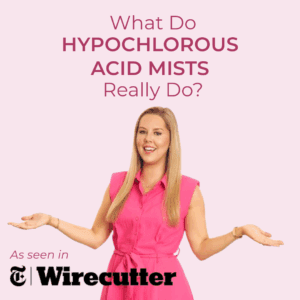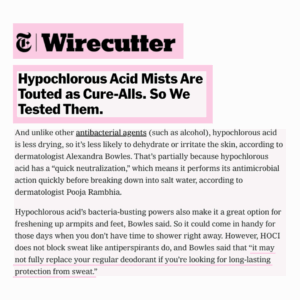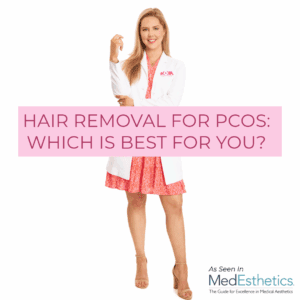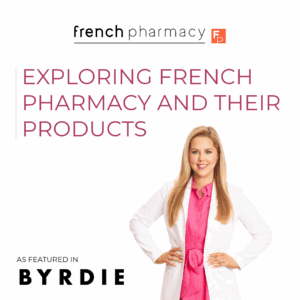What Do Hypochlorous Acid Mists Really Do? | As Seen in The New York Times Wirecutter
Hypochlorous acid mists are gaining traction for their powerful, yet gentle benefits. Dr. Alexandra Bowles shares her opinion on these mists and their ingredients in The New York Times Wirecutter’s article.

Who could benefit from adding hypochlorous acid mists to their skin care routine?
In my experience, these can be especially helpful for those dealing with acne, rosacea, and eczema. It helps cleanse the skin while being very gentle, so it doesn’t exacerbate those conditions. For acne sufferers, it’s a great option because it targets acne-causing bacteria without drying out or irritating the skin. This can also be beneficial in other inflammatory skin conditions such as rosacea or eczema. Because of its anti-inflammatory benefits, I find that hypochlorous acid is a great multi-functional ingredient for anyone with sensitive or reactive skin.
Why does hypochlorous acid often smell like “pool water” as some reviewers report online?
The “pool water” smell comes from the chlorine-like properties of hypochlorous acid. Since hypochlorous acid is a mild form of chlorine, it gives off a scent similar to what you might notice around a pool. This isn’t something to be concerned about, it’s simply a natural characteristic of the ingredient. I’ve noticed, in my own experience and from patient feedback, that the smell usually dissipates quickly once the product is applied to the skin. So while it might be noticeable at first, it’s not something that lasts long, and the benefits far outweigh the initial scent.
Can you explain the role of the ingredients featured in these mists?
Sodium chloride is often included in hypochlorous acid products because it helps to stabilize the formula. It’s also used to balance the pH, which is important for ensuring that the hypochlorous acid remains effective and gentle on the skin. I’ve found that sodium chloride also helps with the overall texture of the spray, making it easy to apply without being too thick or sticky. The hypochlorite ion is what provides the antimicrobial benefits. It’s the active component that helps kill harmful bacteria, which is particularly helpful for acne or for preventing infections in small cuts or wounds. These ingredients are typically included in hypochlorous acid formulas because they support both the stability of the product and its effectiveness in promoting healthier skin.

What are the benefits of muriatic acid?
Some hypochlorous acid sprays use muriatic acid, also known as hydrochloric acid, in very small concentrations. The primary role of muriatic acid in these formulations is to help lower the pH of the product. By doing so, it helps optimize the hypochlorous acid’s effectiveness in killing bacteria and promoting healing. When used in diluted amounts, it’s generally safe for the skin and can help the overall formula penetrate better. Skincare products that balance pH levels commonly include it as an ingredient. This is crucial for maintaining the integrity of the skin barrier.
Why is it important to not use mists like this on wounds like burns and scrapes?
I would be cautious when using mists with ingredients like peptides, copper PCA, or plant extracts on open wounds. These extra ingredients are wonderful for healthy, intact skin because they help with hydration, collagen production, and overall skin health. But when applied to broken skin, they can irritate the skin or interfere with the healing process. The skin is more vulnerable when it’s damaged, and the active ingredients in these products may be too strong for it, potentially delaying healing. For wounds, it’s always best to opt for a simple and gentle product like hypochlorous acid without added actives, unless directed otherwise by a healthcare professional.
What other ingredients should people avoid when looking for a multi-use hypochlorous acid spray that is safe to use on cuts and scrapes as well as sensitive skin?
When you’re looking for a multi-use hypochlorous acid spray that’s safe for cuts, scrapes, and sensitive skin, avoid certain ingredients. Alcohol, fragrances, essential oils, or any harsh preservatives can cause irritation, especially when applied to broken skin. Alcohol, in particular, can be drying and may cause stinging when applied to cuts or scrapes. Fragrances and essential oils can sometimes cause allergic reactions or sensitivity, particularly on sensitive or compromised skin. I’d stick with a simple, clean formulation to keep it effective without the added irritation.
Can you overuse hypochlorous acid?
I understand the concern about overusing hypochlorous acid, but it’s not likely to harm the skin’s microbiome when used properly. Overusing any skincare product can irritate the skin. Hypochlorous acid is much more gentle than other antibacterial agents like alcohol. It works to kill harmful bacteria while leaving skin healthy and intact. That said, if you were to overuse it, you might see some dryness or irritation. Like always, moderation is key. If you’re using hypochlorous acid, it’s good to follow up with a nourishing moisturizer to keep the skin’s balance intact.



